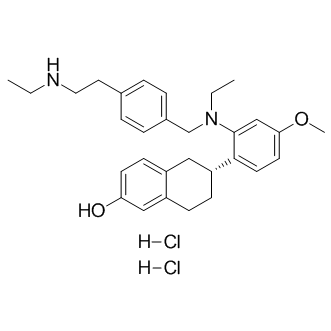| Description: |
Elacestrant dihydrochloride (RAD1901 dihydrochloride) is a selective and orally available estrogen receptor (ERR) degrader with IC50 values of 48 and 870 nM for ERα and ERβ, respectively. |
| Target: |
IC50: 48 nM (ERα), 870 nM (ERβ)[1] |
| In Vivo: |
RAD1901 produces a robust and profound inhibition of tumor growth in MCF-7 xenograft models. RAD1901-treated animals survived longer than those treated with either control or fulvestrant. RAD1901 preserves ovariectomy-induced bone loss and preventes the uterotropic effects of E2[1]. |
| In Vitro: |
RAD1901 selectively binds to and degrades the ER and is a potent antagonist of ER-positive breast cancer cell proliferation. RAD1901 treatment exhibits dose-dependent inhibition of ERα expression, with an EC50 of 0.6 nM. Treatment of ER-positive MCF-7 cells with E2 results in a potent and dose-dependent increase in proliferation, with an EC50 of 4 pM. Treatment of cells with RAD1901 in the presence of 10 pM E2 resultsin a dose-dependent decrease in proliferation, with an IC50 value of 4.2 nM[1]. |
| Kinase Assay: |
RAD1901 is serially diluted in ES2 screening buffer to concentrations ranging from 10 to 10-6 μM. Aliquots (25 μL) of each dilution are added to a black 384-well microtiter plate, in triplicate. The ER–Fluormone complex is prepared as directed, with 2 nM Fluormone ES2 and 30 nM ER. A 25 μL aliquot of this preparation is added to each reaction well. The plates are sealed and incubated in the dark at room temperature for 4 h. Polarization values for each well are measured and plotted against the concentration of the test compound. The IC50 is determined from at least three independent experiments, with E2 serving as a positive control[1]. |
| Cell Assay: |
For proliferation assays, MCF-7 cells are treated with 2% charcoal-stripped FBS–MEM containing 10 pM E2 with either RAD1901 or additional E2 at concentrations ranging from 10-9 to 1 M. The medium is removed after 48 h of incubation and the cells are lysed by adding 100 μl of CellTiter Glo. The plates are gently mixed on a plate shaker for 10 min before the luminescent signal is measured on a luminometer. The EC50 and IC50of the test compound are then defined[1]. |
| Animal Administration: |
Mice: RAD1901 is stored as a dry powder, formulated for use as a homogenous suspension in 0.5% (w/v) methylcellulose in deionized water. Fourteen days after tumor cell implantation, the mice are randomized into nine groups of 15 animals each and treated with vehicle, tamoxifen (1 mg/animal every other day), fulvestrant (0.5 mg/animal daily), or RAD1901 (0.3, 1, 3, 10, 30, 60, 90, and 120 mg/kg daily). Tumor volumes are evaluated twice per week[1]. |
| References: |
[1]. Garner F, et al. RAD1901: a novel, orally bioavailable selective estrogen receptor degrader that demonstrates antitumor activity in breast cancer xenograft models. Anticancer Drugs. 2015 Oct;26(9):948-56. |






















